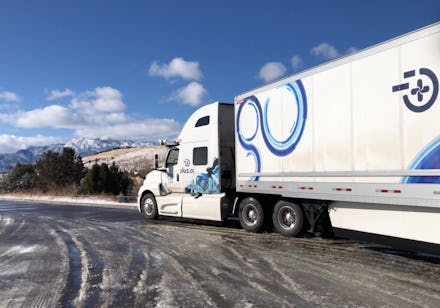How self-driving trucks will change the way we get our food

The first-ever known cross-country commercial freight delivery made by an autonomous truck has been completed, and it went over as smooth as butter. Well, at least that's what it delivered. Silicon Valley startup Plus.ai announced this week that a self-driving semi-truck packed with a payload of 40,000 pounds of Land O'Lakes butter successfully made an over 2,800 mile trip from cross-country trip from Tulare, California to Quakertown, Pennsylvania.
The trip took place over the course of three days and happened just before Thanksgiving. The truck took several scheduled breaks as it made its way across interstates 15 and 70, which made up the vast majority of its travels. While there was a safety driver and engineer on board to observe the truck's behavior and intervene if necessary, the truck made its trip with zero disengagements, meaning that a human never took over for safety purposes. The only time a person touched the wheel was to take over for "federally mandated breaks" and refueling. The rest of the trip was handled by Plus.ai's self-driving technology suite. Called SLAM — an acronym for the very long full name: multimodal sensor fusion, deep learning visual algorithms and simultaneous location and mapping — the technology accomplished the first known instance of a mostly autonomous driving system performing a long-distance commercial freight delivery.
While this is by far the farthest distance that a self-driving semi-truck has been tasked with traveling, it isn't the first time Plus.AI has trusted its autonomous technology with getting goods from Point A to Point B. The company claims that it has been running freight trips every week for about a year now, though the cross-country mission is the first instance that it has publicized.
The trip was not without its challenges. The self-driving truck was tasked with staying on the road during the day and through the night, presenting different lighting challenges for the sensors and cameras to adapt to. The elements also put Plus.ai's SLAM system to the test, as rain and snow poured down on the vehicle as it made its way across the country. Plus.ai reported the truck was largely unfazed by these conditions. That's a relief, as autonomous vehicle systems have previously struggled in similar scenarios. Rain has been a source of confusion for some self-driving cars, and snow and other inclement conditions have also been known to throw the vehicles for a loop — a significant issue seeing as the cars have no control over weather that they face. Last year, an inability to operate at night proved fatal when an Uber vehicle being operated autonomously ran into a pedestrian that it never saw under the cover of night. These are conditions in which self-driving cars will need to prove themselves capable of handling before they can be trusted to have full control over the steering wheel of most vehicles.
Plus.ai's successful journey is certainly a noteworthy advancement in the field of autonomous vehicles, it also pushes us closer to the very real future in which self-driving trucks will be making deliveries all over the country — leaving millions of people without work. It is estimated that there are about 3.5 million truck drivers in the United States and about 7.4 million people working in adjacent positions in the trucking and shipping industry. Driving a truck is the most popular occupation in 29 states, and the people who work those jobs do not fit neatly into a demographic that can easily be transferred over to another line of work. The average trucker is 49 years old and has a high school education. Removing those drivers from the road and replacing them with autonomous systems will not only leave them without jobs but will also disrupt an entire ecosystem that has been created around the shipping industry. Everyone from drivers to dispatchers to roadside hotels and restaurants that subsist on delivery drivers will feel the impact of the change.
Some have predicted widespread adoption of autonomous systems for freight deliveries as soon as by 2022. The Los Angeles Times reported that by 2026, as many as 1.7 million truck drivers could be out of a job because of automation. Regulation, both at the state and federal level, may slow the shift of an industry hungry to cut costs — even if systems have been proven entirely safe yet — but Plus.ai's trip shows a glimpse of a future that is just around the corner. Just how deep the impact will run is yet to be seen.